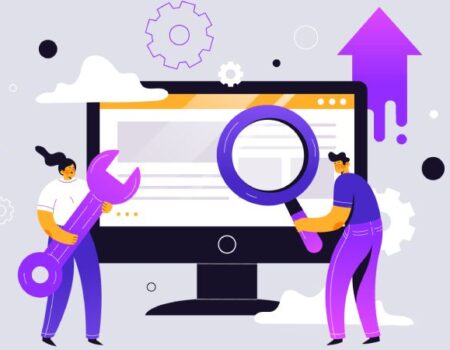Integrating SEO into Omnichannel Marketing for Seamless Engagement
In today’s digital marketing landscape, connecting the dots across multiple platforms isn’t optional—it’s essential. SEO plays a central role in delivering consistent, engaging brand experiences across every channel.
Modern consumers no longer stick to a single source when discovering content. Whether it’s traditional search engines, LLMs, or social platforms, they jump between channels—and they expect brands to keep up.
To meet these expectations, cross-channel marketing must prioritize brand consistency and personalization. That’s where SEO steps in—working behind the scenes to tie everything together and power a customer-first strategy.
Why SEO Must Be Embedded Across All Channels
The path to purchase is no longer linear. The rise of zero-click searches, AI-powered platforms, and the agent economy has added layers of complexity to the customer journey.
Let’s explore seven reasons why weaving SEO into your omnichannel marketing approach is no longer optional in 2025:
1. The Decline of Third-Party Cookies
With third-party cookies fading, brands are losing traditional tracking methods. This limits visibility into user behavior. But omnichannel strategies help unify data sources, creating a full-funnel picture and ensuring more personalized experiences despite the changes.
2. AI Search and the Agent Economy
LLMs and AI tools now guide users to answers directly, often without a traditional web visit. This new agent economy is reshaping digital interactions—and marketers need SEO strategies that work across platforms where AI delivers content from top-performing organic sources.
3. The Rise of Zero-Click Interactions
Consumers are getting answers instantly on SERPs. As a result, top-of-funnel traffic from informational keywords is shrinking. But SEO remains your strongest long-term channel for organic visibility—especially when paired with an omnichannel strategy that re-engages users across platforms.
4. SEO Is Still the Cornerstone
Even with new challenges, search engine optimization is the top-performing channel in terms of ROI. Google’s AI-generated results still pull from high-ranking content. Strong SEO ensures your content stays visible—even when users don’t click through.
5. Multimodal Search Requires Rich Asset Optimization
Search is now more than just text. Users explore content through video, voice, and images. Optimizing across all formats—PDFs, infographics, video transcripts—is key to cross-channel marketing success.
6. Personalized Experiences Are No Longer Optional
Personalization is critical to customer engagement. According to McKinsey, 71% of users expect it, and over 75% get frustrated by generic messaging. Brands that adapt their omnichannel efforts to focus on user experience (UX) and intent see real revenue growth.
7. The Agent-Led, Unified Customer Experience
AI agents now stitch together insights from multiple platforms to offer a smoother customer journey. As automation grows, SEO must align with personalization and seamless delivery across every interaction point.
Solving the Visibility Dilemma in Digital Marketing
With consumers bouncing across platforms, many marketers are left wondering:
- How do you uncover intent if users don’t click your link?
- How can you collect meaningful data once a user leaves without converting?
- How do you craft a strategy across SEO, paid, and content when visibility is so limited?
Answer: through omnichannel marketing powered by SEO. This unified strategy ensures you’re present at every stage of the customer journey, capturing intent signals and maintaining relevance—even when attribution gets messy.
By prioritizing SEO across all channels, you bridge gaps in visibility, deliver better user experience, and create personalized journeys that convert.
Building blocks of an omnichannel strategy
A true omnichannel strategy is no longer limited to traditional marketing channels like SEO, paid, email, social media, and so on.
Today, it’s about delivering a unified experience at every stage of the customer journey and at every possible touchpoint.
That means effectively using channel-agnostic strategies and tactics, such as personalization, AI agents, conversion optimization, A/B testing, and co-optimization.
Here are five building blocks for creating an omnichannel strategy that truly engages your audiences—consistently and intelligently—across touchpoints in an AI-powered world.
Reliable data
Ensure you have the right infrastructure to collect and segment customer data accurately.
AI can then be layered to:
- Build audience cohorts
- Predict user journeys
- Deliver real-time personalized experiences
Dig deeper: How to boost your marketing revenue with personalization, connectivity and data
Artificial intelligence
An organizational AI strategy is key—not just for content generation, but also for improving:
- Efficiency
- Process automation
- Customer data segmentation
- Forecasting
- Real-time personalization at scale
And more
Dig deeper: 4 pillars of an effective enterprise AI strategy
Digital assets
A digital asset manager (DAM) lets you centralize, optimize, and distribute all your assets across channels—ensuring consistency and reducing duplication.
Infrastructure
You need search-friendly infrastructure and a content management system that supports:
- Easy crawling and indexing
- Personalized content delivery
- Scalable performance
Dig deeper: How to select a CMS that powers SEO, personalization, and growth
Structured data and entity optimization
Search engines—including LLMs—identify entities in your content to understand context.
Structured data (schema markup) helps them detect those entities and your digital assets—maximizing visibility and SERP saturation.
9 Steps to Integrating SEO into an Omnichannel Customer Journey
You can begin building your omnichannel strategy while closing any gaps identified in your foundational building blocks.
Step 1: Audience and Intent Mapping
Start by understanding your audience and their intent. Identifying key personas and what they’re looking for is foundational to your omnichannel strategy. Review:
- Content performance: Analyze how different page types perform (e.g., category pages, product pages, location pages, blog posts) to uncover gaps in your content strategy.
- Search engagement insights: Use Search Console data to spot high-intent keywords with low CTRs and address them through zero-click content or CTR optimization.
- Channel overlaps: Look at how audiences interact across channels. Paid and organic efforts, for instance, should be integrated to fully saturate the funnel and maximize ROI.
- Conversion optimization: High-engagement content reveals valuable visitor intent. Use this insight to fuel A/B testing, UI/UX improvements, and personalization initiatives.
Step 2: Define Clear Strategic Goals
Establish SMART goals aligned with your business objectives. This step ensures your omnichannel SEO strategy drives tangible results.
- Set specific, measurable business objectives (e.g., revenue growth, customer retention, market share expansion).
- Define key performance indicators (KPIs) at both channel and overall levels. For visibility goals, focus on impressions, clicks, and rich results visibility.
- Create baseline metrics to measure improvement over time.
- Develop a cross-channel measurement framework to account for attribution complexities.
Step 3: Map the Customer Journey Across All Touchpoints
The traditional funnel has evolved. Brands must now deliver fast, high-quality interactions at every stage and touchpoint.
Build a 360° view of customer interactions:
- Create detailed audience personas based on segments.
- Use path analysis to uncover cross-channel behavior patterns and common use cases.
- Aggregate and centralize data from all touchpoints: website analytics, CRM, sales, app usage, etc.
- Segment audiences by behavioral patterns, not just demographics.
- Quantify the attribution value of various touchpoints.
- Measure channel preferences and performance across different segments.
Step 4: Omnichannel Audit
Audit your current performance across all relevant areas to uncover opportunities for improvement.
- SEO audit: Assess search visibility, technical health, and overall organic performance.
- Content audit: Evaluate performance, topical and entity coverage, engagement, conversion metrics, and cross-channel synergy.
- Local presence assessment: Measure local SEO visibility and regional engagement.
- Experience audit: Identify drop-off points and sources of friction between channels.
- Data and technology assessment: Ensure data collection and measurement systems are robust.
- Full-funnel audit: Analyze past visitor behavior to identify what drives engagement or causes drop-offs—use this data to inform co-optimization, A/B testing, and personalized experiences.
Step 5: Develop Your Integrated Channel Strategy
Align all your channels so they work cohesively to support your broader goals.
- Prioritize channels based on attribution models and customer value.
- Use machine learning and predictive analytics to forecast impact.
- Determine your optimal channel mix with data-driven insights.
- Set channel-specific goals that roll up into overarching business objectives.
- Establish frameworks for ongoing testing and performance validation.
- Define how each channel will complement others throughout the customer journey.
Step 6: Content Orchestration Strategy
While a content strategy focuses on what content is needed, a content orchestration strategy involves planning how content is delivered across channels to drive seamless audience interaction and engagement.
Friction Analysis
Evaluate how users interact with your content to identify and resolve areas of friction. This includes:
- Inconsistencies in tone, messaging, or design
- Misalignment between content and user intent
- Ineffective delivery mechanisms (e.g., text-heavy pages where video might work better)
Content Intelligence
Use performance data to assess existing content across channels and identify gaps or competitive opportunities aligned with audience personas and business goals.
Key steps:
- Identify underperforming assets for optimization
- Spot content gaps across journey stages and platforms
- Uncover cross-linking opportunities to build content hubs
- Prioritize content creation that closes competitive gaps and supports strategic goals
Cross-Channel Content Strategy
Once friction and gaps are addressed, tailor your content strategy for each channel based on business objectives and customer journey stages:
- Awareness stage: Broader, educational content (e.g., blog posts, social media)
- Consideration stage: Comparison or review-style content (e.g., product detail pages, case studies)
- Conversion stage: High-intent landing pages targeting transactional keywords
Content Optimization
Go beyond keyword targeting to optimize for discoverability and engagement:
- Fill topical and contextual gaps
- Implement entity optimization for better semantic understanding
- Enhance click-through rates (CTR) with strategic titles and meta descriptions
- Optimize visual content (images, videos, graphics)
- Drive conversions with personalized messaging, optimized CTAs, UI/UX enhancements, A/B testing, and CRO strategies
Step 7: Infrastructure and Technical SEO
A solid technical foundation ensures your content is accessible, crawlable, and indexed correctly. Focus on:
- Fixing crawl and indexing issues
- Ensuring mobile optimization across all digital touchpoints
- Implementing nested schema markup for structured data visibility
- Enhancing site speed and meeting Core Web Vitals thresholds
- Testing for cross-device compatibility
- Applying proper canonicalization for multi-language or regional content
- Improving web accessibility following ADA and WCAG standards to enhance usability and search performance
Partner with our Digital Marketing Agency
Ask Engage Coders to create a comprehensive and inclusive digital marketing plan that takes your business to new heights.
Step 8: Engagement and Conversion Optimization
Maximize impact by using real-time data and personalization to boost engagement and conversions:
- Deliver personalized experiences at scale based on channel, location, behavior, and intent
- Deploy AI agents to help users navigate, engage, and convert efficiently
- Create behavior-driven remarketing strategies
- Run A/B tests across channels with consistent methodology
- Continuously track and measure engagement and conversion performance against success KPIs
Step 9: Continuously Test, Measure, Learn, and Optimize
Omnichannel strategies are never “set and forget.” Commit to continuous learning and iterative improvements:
- Monitor performance across all channels with integrated BI dashboards
- Implement attribution models that reflect real-world, cross-channel journeys
- Regularly test new touchpoints and optimize customer journey enhancements
- Gather direct feedback from users on cross-channel experiences
- Refine your strategy to adapt to search engine algorithm changes and evolving consumer behaviors
SEO’s Role in Delivering a Unified, Cross-Channel Experience
Integrating SEO into the omnichannel customer journey goes beyond simply increasing visibility in search engines.
At its core, SEO helps create discoverable, consistent, and personalized experiences that guide users fluidly across touchpoints — from search to conversion and beyond.
By implementing this nine-step framework, your organization can:
- Break down departmental silos and foster collaboration across teams
- Align cross-functional efforts around real customer needs and intent
- Deliver unified experiences that feel seamless to the user, regardless of channel
- Drive long-term, sustainable growth through smarter engagement and data-driven optimization
When SEO is treated as a strategic driver of the customer experience — not just a traffic lever — it becomes a powerful engine behind omnichannel success.








